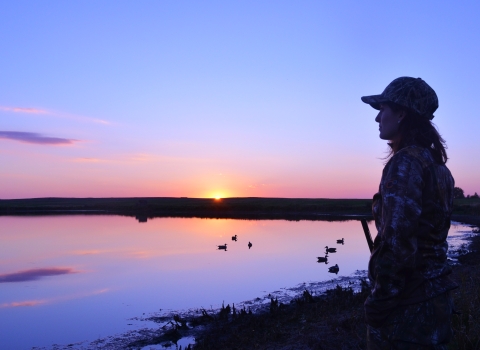DENVER – Since its establishment in 1912, the National Elk Refuge in Jackson Hole, Wyoming, has continually supported a variety of native wildlife, including the iconic Jackson elk herd. As part of ongoing planning and management efforts, today the U.S. Fish and Wildlife Service opened a 30-day public comment period on a draft Environmental Assessment (EA) and associated Bison and Elk Management Step-down Plan for the refuge.
Currently, there are an estimated 11,000 elk in the Jackson herd, and upwards of 6,000-7,000 of those individuals winter on the refuge. Reducing both the number and concentration of elk on refuge lands during winter can help to mitigate wildlife disease threats, reduce or prevent habitat degradation, and yield positive impacts for other native wildlife species.
The draft EA and Step-down Plan build upon the refuge’s 2007 Bison and Elk Management Plan and Environmental Impact Statement, which outlined strategies to lessen the reliance of wintering elk on supplemental feeding at the refuge. Developed with staff of the Wyoming Game and Fish Department and other conservation partners, the Step-down Plan sets a target of 5,000 wintering elk on refuge lands. Once finalized, the Step-down Plan will help the refuge achieve measurable progress towards goals and objectives related to wildlife disease management, refuge elk and bison numbers, sustainable wildlife populations, and habitat conservation.
Supplemental winter feeding of elk on the refuge began in 1910 in order to reduce winter mortality. Annual initiation and ending of supplemental feeding depends upon a number of factors, including: elk and bison numbers on the refuge; elk and bison distribution; temperatures; snow depth; and the availability of standing natural forage. While supplemental feeding has been a longstanding practice on the refuge, the November 2018 detection of chronic-wasting disease near the refuge’s boundary has renewed a sense of urgency to adjust elk management practices in the area.
The draft EA and Step-down Plan are available for review on the refuge’s website. Members of the public are invited to submit comments from September 30, 2019 through October 30, 2019. Public comments concerning the draft EA and Step-down Plan can be submitted via email to NationalElkRefuge@fws.gov or by postal mail to:
U.S. Fish and Wildlife Service, Mountain-Prairie Region, NWRS/Planning, Attn: Toni Griffin, 134 Union Blvd., Lakewood, Colorado 80228-1807.
Following the public comment period, the Service will analyze comments received, publish a final EA and Step-down Plan, by December 31, 2019, and then begin implementation. Moving forward, the Service remains committed to working with local, state, and federal partners, and a final EA and Step-down Plan are expected to publish by December 31, 2019.
The National Elk Refuge was established in 1912 to provide, preserve, restore, and manage lands for wintering elk, birds, and other big game animals. Today, the refuge contains over 24,500 acres of wetland, grassland, sagebrush sagebrush
The western United States’ sagebrush country encompasses over 175 million acres of public and private lands. The sagebrush landscape provides many benefits to our rural economies and communities, and it serves as crucial habitat for a diversity of wildlife, including the iconic greater sage-grouse and over 350 other species.
Learn more about sagebrush , forest, woodland, and other habitats. It provides visitors with opportunities for hunting, fishing, wildlife viewing, photography, environmental education, and interpretation, and remains an iconic national wildlife refuge national wildlife refuge
A national wildlife refuge is typically a contiguous area of land and water managed by the U.S. Fish and Wildlife Service for the conservation and, where appropriate, restoration of fish, wildlife and plant resources and their habitats for the benefit of present and future generations of Americans.
Learn more about national wildlife refuge destination for visitors. It is one of over 560 refuges in the National Wildlife Refuge System.
The U.S. Fish and Wildlife Service works with others to conserve, protect, and enhance fish, wildlife, plants, and their habitats for the continuing benefit of the American people. For more information, or connect connect with us through any of these social media channels: Facebook, Twitter, Flickr, YouTube, and Instagram.



